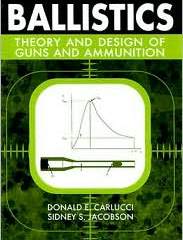|
Caliber and Ammunition - Hand Guns and Rifles
Modern rifle and hand gun ammunition consists of primarily
four parts: a primer (or cap); a case (or shell); gun powder; and a
bullet.
Here's a look at a center fire rifle and a hand gun cartridge
borrowed from
.
 Bullet
– a single projectile fired from a firearm. Some mistakenly consider
the entire round of ammunition to be the bullet, in actuality it is
only the tip of the round.
Bullet
– a single projectile fired from a firearm. Some mistakenly consider
the entire round of ammunition to be the bullet, in actuality it is
only the tip of the round.
Case
– usually made of brass and contains
the powder charge, the primer and the bullet. Before development of the
metallic cartridge, the term was used to mean a roll or case of paper
containing powder and shot. A center fire cartridge refers all pistol
and rifle cartridges that have primers in the center of the base, while
rim fire cartridges have primer in the rim.
Crimp
– the portion of a cartridge case that is bent inward to hold the bullet in place.
Powder
– the general term for any chemical
compound or mixture used in firearms that burns upon ignition. The
gases produced by this rapid combustion propel the bullet down the
bore. One major type is black powder, which is a mixture of charcoal,
sulfur and saltpeter. It’s used in older cartridges. Another major type
is smokeless powder, which is principally used in modern ammunition.
It’s a granular nitrated chemical compound.
Primer
– the collective term for the chemical
primer compound, cup and anvil. When the primer is struck, it ignites
the powder charge.
Rim
– the edge on the base of a cartridge
case. It’s the part of the case gripped by the extractor to remove it
from the chamber. In some cartridges it also prevents the case from
entering the chamber.
|
|
|
Caliber is a measurement of the diameter of the barrel's bore or bullet for rifles and handguns. The measurement can be in hundredths or thousandths of an inch, or the metric system. The larger the number, the larger the ammunition. One inch is about 25 mm, so a .22 caliber (22/100th of an inch) is smaller than a 9 mm (just shy of half an inch), and a .50 caliber is ] of the three. Here are a few photos that compare various sizes of caliber.
Click on the pictures to enlarge.
 The additional numbers and descriptions for ammunition cartridges indicate changes in the casing,bullet design, amount of powder, etc. to change various aspects of performance such as recoil, velocity, trajectory, accuracy and what happens to the bullet when it meets its target. Modern bullets may also incorporate aerodynamic designs for accuracy over ranges of several hundreds yards. Bullets can also be made from various combinations of materials (lead, copper etc.), equipped with tips designed to pierce various materials or to explode on impact. Modern ballistics (cartridge and bullet design) is a full fledged science -
click on the book cover
to see an example table of contents. We'll just provide a few examples.
The additional numbers and descriptions for ammunition cartridges indicate changes in the casing,bullet design, amount of powder, etc. to change various aspects of performance such as recoil, velocity, trajectory, accuracy and what happens to the bullet when it meets its target. Modern bullets may also incorporate aerodynamic designs for accuracy over ranges of several hundreds yards. Bullets can also be made from various combinations of materials (lead, copper etc.), equipped with tips designed to pierce various materials or to explode on impact. Modern ballistics (cartridge and bullet design) is a full fledged science -
click on the book cover
to see an example table of contents. We'll just provide a few examples.
Some cartridges with reduced recoil are intended for "tactical" (personal protection) use and some are "cowboy" loads which are designed for demonstration or gun shows. Changes in recoil are typically accomplished with the quality or quantity of the gunpowder or primer.
Another example is the .30-06 (pronounced “thirty-aught-six”, "thirty-oh-six"). The .30-06 is a .30 caliber cartridge was originally developed for the military in 1906 to meet a need for improved long range machine gun performance. The powder load (increased for power and range) and bullet shape (more aerodynamic) vastly improved velocity, range, accuracy and caused devastating damage when equipped with deforming or fragmenting bullets. The .30-06 was the U.S. military round for 50 years and remains widely used today. Check out this article in
Wikipedia
for more details.
 When bullets strike a target, they can cause damage by striking vital body parts, causing bleeding, and by the transfer of energy (shock). Larger caliber bullets generally cause more damage than smaller caliber bullets and higher velocity bullets generally cause more damage than slower moving bullets. Damage is also caused by bullets that deform (change shape) or fragment upon impact. A fragmenting bullet acts like shrapnel causing multiple paths of damage from a single shot.
When bullets strike a target, they can cause damage by striking vital body parts, causing bleeding, and by the transfer of energy (shock). Larger caliber bullets generally cause more damage than smaller caliber bullets and higher velocity bullets generally cause more damage than slower moving bullets. Damage is also caused by bullets that deform (change shape) or fragment upon impact. A fragmenting bullet acts like shrapnel causing multiple paths of damage from a single shot.
 A deforming bullet looses its aerodynamic shape and increases the diameter and surface area on the front of the bullet once it enters its target. Rather than passing cleanly through the target, the kinetic energy of the bullet in motion is quickly transferred to the target by a pressure wave created from inside the target. This pressure wave causes damage,
hydrostatic shock
, to a much larger area than simply the path of the bullet moving through the target.
A deforming bullet looses its aerodynamic shape and increases the diameter and surface area on the front of the bullet once it enters its target. Rather than passing cleanly through the target, the kinetic energy of the bullet in motion is quickly transferred to the target by a pressure wave created from inside the target. This pressure wave causes damage,
hydrostatic shock
, to a much larger area than simply the path of the bullet moving through the target.
 The illustrations at right are still photos from a high speed video of the
deforming bullet passing through a 3-inch section of ballistics gel. Note how quickly the bullet deforms and the pressure wave begins. The final illustration shows how the shock wave fully engulfs the ballistic jell causing wide spread damage.
The illustrations at right are still photos from a high speed video of the
deforming bullet passing through a 3-inch section of ballistics gel. Note how quickly the bullet deforms and the pressure wave begins. The final illustration shows how the shock wave fully engulfs the ballistic jell causing wide spread damage.
|
Click on the pictures at right
to see the video, or a video of the Barnes Bullets fragmenting round called the Varmint Grenade.
Caution
, this video shows real kills and can be a shock if you're not prepared.
|

|

|
|


 Bullet
– a single projectile fired from a firearm. Some mistakenly consider
the entire round of ammunition to be the bullet, in actuality it is
only the tip of the round.
Bullet
– a single projectile fired from a firearm. Some mistakenly consider
the entire round of ammunition to be the bullet, in actuality it is
only the tip of the round.





 When bullets strike a target, they can cause damage by striking vital body parts, causing bleeding, and by the transfer of energy (shock). Larger caliber bullets generally cause more damage than smaller caliber bullets and higher velocity bullets generally cause more damage than slower moving bullets. Damage is also caused by bullets that deform (change shape) or fragment upon impact. A fragmenting bullet acts like shrapnel causing multiple paths of damage from a single shot.
When bullets strike a target, they can cause damage by striking vital body parts, causing bleeding, and by the transfer of energy (shock). Larger caliber bullets generally cause more damage than smaller caliber bullets and higher velocity bullets generally cause more damage than slower moving bullets. Damage is also caused by bullets that deform (change shape) or fragment upon impact. A fragmenting bullet acts like shrapnel causing multiple paths of damage from a single shot.
 A deforming bullet looses its aerodynamic shape and increases the diameter and surface area on the front of the bullet once it enters its target. Rather than passing cleanly through the target, the kinetic energy of the bullet in motion is quickly transferred to the target by a pressure wave created from inside the target. This pressure wave causes damage,
A deforming bullet looses its aerodynamic shape and increases the diameter and surface area on the front of the bullet once it enters its target. Rather than passing cleanly through the target, the kinetic energy of the bullet in motion is quickly transferred to the target by a pressure wave created from inside the target. This pressure wave causes damage,
 The illustrations at right are still photos from a high speed video of the
deforming bullet passing through a 3-inch section of ballistics gel. Note how quickly the bullet deforms and the pressure wave begins. The final illustration shows how the shock wave fully engulfs the ballistic jell causing wide spread damage.
The illustrations at right are still photos from a high speed video of the
deforming bullet passing through a 3-inch section of ballistics gel. Note how quickly the bullet deforms and the pressure wave begins. The final illustration shows how the shock wave fully engulfs the ballistic jell causing wide spread damage.


